Contents |
|||||||||||||||||||||||||||||||||||||||||||||||||||||||||||||||||||||||||||||||||||||||||||||||||||||||||||||||||
| Preface | |||||||||||||||||||||||||||||||||||||||||||||||||||||||||||||||||||||||||||||||||||||||||||||||||||||||||||||||||
| What Are Autoimmune Diseases? | |||||||||||||||||||||||||||||||||||||||||||||||||||||||||||||||||||||||||||||||||||||||||||||||||||||||||||||||||
| Who Is Affected by Autoimmune Diseases? | |||||||||||||||||||||||||||||||||||||||||||||||||||||||||||||||||||||||||||||||||||||||||||||||||||||||||||||||||
| What Are the Causes of Autoimmune Diseases? | |||||||||||||||||||||||||||||||||||||||||||||||||||||||||||||||||||||||||||||||||||||||||||||||||||||||||||||||||
| Are they contagious? | |||||||||||||||||||||||||||||||||||||||||||||||||||||||||||||||||||||||||||||||||||||||||||||||||||||||||||||||||
| Are they inherited? | |||||||||||||||||||||||||||||||||||||||||||||||||||||||||||||||||||||||||||||||||||||||||||||||||||||||||||||||||
| What other factors may influence the development of autoimmune diseases? | |||||||||||||||||||||||||||||||||||||||||||||||||||||||||||||||||||||||||||||||||||||||||||||||||||||||||||||||||
 |
How Does the Immune System Work? | ||||||||||||||||||||||||||||||||||||||||||||||||||||||||||||||||||||||||||||||||||||||||||||||||||||||||||||||||
| T and B Cells | |||||||||||||||||||||||||||||||||||||||||||||||||||||||||||||||||||||||||||||||||||||||||||||||||||||||||||||||||
| Macrophages and Neutrophils | |||||||||||||||||||||||||||||||||||||||||||||||||||||||||||||||||||||||||||||||||||||||||||||||||||||||||||||||||
| MHC and Co-Stimulatory Molecules | |||||||||||||||||||||||||||||||||||||||||||||||||||||||||||||||||||||||||||||||||||||||||||||||||||||||||||||||||
| Cytokines and Chemokines | |||||||||||||||||||||||||||||||||||||||||||||||||||||||||||||||||||||||||||||||||||||||||||||||||||||||||||||||||
| Antibodies | |||||||||||||||||||||||||||||||||||||||||||||||||||||||||||||||||||||||||||||||||||||||||||||||||||||||||||||||||
| Autoantibodies | |||||||||||||||||||||||||||||||||||||||||||||||||||||||||||||||||||||||||||||||||||||||||||||||||||||||||||||||||
| Immune Complexes and the Complement System | |||||||||||||||||||||||||||||||||||||||||||||||||||||||||||||||||||||||||||||||||||||||||||||||||||||||||||||||||
| Genetic Factors | |||||||||||||||||||||||||||||||||||||||||||||||||||||||||||||||||||||||||||||||||||||||||||||||||||||||||||||||||
| How Are Autoimmune Diseases Diagnosed? | |||||||||||||||||||||||||||||||||||||||||||||||||||||||||||||||||||||||||||||||||||||||||||||||||||||||||||||||||
| How Are Autoimmune Diseases Treated? | |||||||||||||||||||||||||||||||||||||||||||||||||||||||||||||||||||||||||||||||||||||||||||||||||||||||||||||||||
 |
What Are Some Examples of Autoimmune Diseases? | ||||||||||||||||||||||||||||||||||||||||||||||||||||||||||||||||||||||||||||||||||||||||||||||||||||||||||||||||
| Rheumatoid Arthritis | |||||||||||||||||||||||||||||||||||||||||||||||||||||||||||||||||||||||||||||||||||||||||||||||||||||||||||||||||
| Multiple Sclerosis | |||||||||||||||||||||||||||||||||||||||||||||||||||||||||||||||||||||||||||||||||||||||||||||||||||||||||||||||||
| Immune-Mediated or Type 1 Diabetes Mellitus | |||||||||||||||||||||||||||||||||||||||||||||||||||||||||||||||||||||||||||||||||||||||||||||||||||||||||||||||||
| Inflammatory Bowel Diseases | |||||||||||||||||||||||||||||||||||||||||||||||||||||||||||||||||||||||||||||||||||||||||||||||||||||||||||||||||
| Systemic Lupus Erythematosus | |||||||||||||||||||||||||||||||||||||||||||||||||||||||||||||||||||||||||||||||||||||||||||||||||||||||||||||||||
| Psoriasis | |||||||||||||||||||||||||||||||||||||||||||||||||||||||||||||||||||||||||||||||||||||||||||||||||||||||||||||||||
| Scleroderma | |||||||||||||||||||||||||||||||||||||||||||||||||||||||||||||||||||||||||||||||||||||||||||||||||||||||||||||||||
| Autoimmune Thyroid Diseases | |||||||||||||||||||||||||||||||||||||||||||||||||||||||||||||||||||||||||||||||||||||||||||||||||||||||||||||||||
| What Research Is Under Way on Autoimmune Diseases? | |||||||||||||||||||||||||||||||||||||||||||||||||||||||||||||||||||||||||||||||||||||||||||||||||||||||||||||||||
| Resources | |||||||||||||||||||||||||||||||||||||||||||||||||||||||||||||||||||||||||||||||||||||||||||||||||||||||||||||||||
| Glossary | |||||||||||||||||||||||||||||||||||||||||||||||||||||||||||||||||||||||||||||||||||||||||||||||||||||||||||||||||
| May 1998 NIH Publication No. 98-4273 | |||||||||||||||||||||||||||||||||||||||||||||||||||||||||||||||||||||||||||||||||||||||||||||||||||||||||||||||||
| Understanding Autoimmune Diseases | |||||||||||||||||||||||||||||||||||||||||||||||||||||||||||||||||||||||||||||||||||||||||||||||||||||||||||||||||
| Preface | This booklet contains information about autoimmune diseases.
You will not find everything there is to know about autoimmune diseases
here, however. In fact, the information presented here may prompt you to
think of more questions about autoimmune diseases because autoimmune
diseases are complex. We have tried to anticipate which terms will need further definition and clarification. Those terms, when they first appear in the text, are in italics. Italicized words and phrases are defined in the Glossary at the end of the booklet. You will find more in-depth and detailed resources at your local library or through your health care provider. The Internet is a valuable source of information as well. Start by doing a search on the National Institutes of Health (NIH) Web site at http://www.nih.gov/ for information on the broad range of research conducted by NIH, including autoimmune diseases. | ||||||||||||||||||||||||||||||||||||||||||||||||||||||||||||||||||||||||||||||||||||||||||||||||||||||||||||||||
| What Are Autoimmune Diseases? | The word "auto" is the Greek word for self. The immune system is a
complicated network of cells and cell components (called
molecules) that normally work to defend the body and eliminate
infections caused by bacteria, viruses, and other invading microbes. If a
person has an autoimmune disease, the immune system mistakenly attacks
self, targeting the cells, tissues, and organs of a person's own body. A
collection of immune system cells and molecules at a target site is
broadly referred to as inflammation. There are many different autoimmune diseases, and they can each affect the body in different ways. For example, the autoimmune reaction is directed against the brain in multiple sclerosis and the gut in Crohn's disease. In other autoimmune diseases such as systemic lupus erythematosus (lupus), affected tissues and organs may vary among individuals with the same disease. One person with lupus may have affected skin and joints whereas another may have affected skin, kidney, and lungs. Ultimately, damage to certain tissues by the immune system may be permanent, as with destruction of insulin-producing cells of the pancreas in Type 1 diabetes mellitus. | ||||||||||||||||||||||||||||||||||||||||||||||||||||||||||||||||||||||||||||||||||||||||||||||||||||||||||||||||
| Who Is Affected by Autoimmune Diseases? | Many of the autoimmune diseases are rare. As a group, however,
autoimmune diseases afflict millions of Americans. Most autoimmune
diseases strike women more often than men; in particular, they affect
women of working age and during their childbearing years. Some autoimmune diseases occur more frequently in certain minority populations. For example, lupus is more common in African-American and Hispanic women than in Caucasian women of European ancestry. Rheumatoid arthritis and scleroderma affect a higher percentage of residents in some Native American communities than in the general U.S. population. Thus, the social, economic, and health impact from autoimmune diseases is far-reaching and extends not only to family but also to employers, co-workers, and friends. | ||||||||||||||||||||||||||||||||||||||||||||||||||||||||||||||||||||||||||||||||||||||||||||||||||||||||||||||||
| What Are the Causes of Autoimmune Diseases? | Are they contagious? No
autoimmune disease has ever been shown to be contagious or "catching."
Autoimmune diseases do not spread to other people like infections. They
are not related to AIDS, nor are they a type of cancer. Are they inherited? The genes people inherit contribute to their susceptibility for developing an autoimmune disease. Certain diseases such as psoriasis can occur among several members of the same family. This suggests that a specific gene or set of genes predisposes a family member to psoriasis. In addition, individual family members with autoimmune diseases may inherit and share a set of abnormal genes, although they may develop different autoimmune diseases. For example, one first cousin may have lupus, another may have dermatomyositis, and one of their mothers may have rheumatoid arthritis. | ||||||||||||||||||||||||||||||||||||||||||||||||||||||||||||||||||||||||||||||||||||||||||||||||||||||||||||||||
| |||||||||||||||||||||||||||||||||||||||||||||||||||||||||||||||||||||||||||||||||||||||||||||||||||||||||||||||||
| The development of an autoimmune disease may be influenced by the genes a person inherits together with the way the person's immune system responds to certain triggers or environmental influences. | What other factors may influence the development of autoimmune diseases? Some autoimmune diseases are known to begin or worsen with certain triggers such as viral infections. Sunlight not only acts as a trigger for lupus but can worsen the course of the disease. It is important to be aware of the factors that can be avoided to help prevent or minimize the amount of damage from the autoimmune disease. Other less understood influences affecting the immune system and the course of autoimmune diseases include aging, chronic stress, hormones, and pregnancy. | ||||||||||||||||||||||||||||||||||||||||||||||||||||||||||||||||||||||||||||||||||||||||||||||||||||||||||||||||
| How Does the Immune System Work? | The immune system defends the body from attack by invaders recognized as foreign. It is an extraordinarily complex system that relies on an elaborate and dynamic communications network that exists among the many different kinds of immune system cells that patrol the body. At the heart of the system is the ability to recognize and respond to substances called antigens whether they are infectious agents or part of the body (self antigens). | ||||||||||||||||||||||||||||||||||||||||||||||||||||||||||||||||||||||||||||||||||||||||||||||||||||||||||||||||
| Cells and molecules of the immune system protect the nose from attack by a virus. | 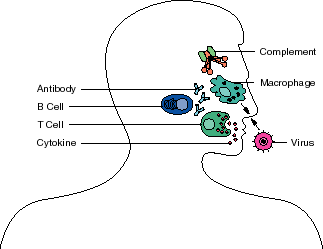 | ||||||||||||||||||||||||||||||||||||||||||||||||||||||||||||||||||||||||||||||||||||||||||||||||||||||||||||||||
 T cell (lymphocyte) with a T-cell receptor on its surface |
T and B Cells Most immune system cells are white blood cells, of which there are many types. Lymphocytes are one type of white blood cell, and two major classes of lymphocytes are T cells and B cells. T cells are critical immune system cells that help to destroy infected cells and coordinate the overall immune response. The T cell has a molecule on its surface called the T-cell receptor. This receptor interacts with molecules called MHC (major histocompatibility complex). MHC molecules are on the surfaces of most other cells of the body and help T cells recognize antigen fragments. B cells are best known for making antibodies. An antibody binds to an antigen and marks the antigen for destruction by other immune system cells. Other types of white blood cells include macrophages and neutrophils. | ||||||||||||||||||||||||||||||||||||||||||||||||||||||||||||||||||||||||||||||||||||||||||||||||||||||||||||||||
| Macrophages and Neutrophils
Macrophages and neutrophils circulate in the blood and survey the body for foreign substances. When they find foreign antigens, such as bacteria, they engulf and destroy them. Macrophages and neutrophils destroy foreign antigens by making toxic molecules such as reactive oxygen intermediate molecules. If production of these toxic molecules continues unchecked, not only are the foreign antigens destroyed, but tissues surrounding the macrophages and neutrophils are also destroyed. For example, in individuals with the autoimmune disease called Wegener's granulomatosis, overactive | |||||||||||||||||||||||||||||||||||||||||||||||||||||||||||||||||||||||||||||||||||||||||||||||||||||||||||||||||
| A macrophage engulfing a bacterium and releasing packets of toxic molecules (reactive oxygen intermediates) that break down and destroy the bacterium. |  | ||||||||||||||||||||||||||||||||||||||||||||||||||||||||||||||||||||||||||||||||||||||||||||||||||||||||||||||||
| macrophages and neutrophils that invade blood vessels produce many toxic molecules and contribute to damage of the blood vessels. In rheumatoid arthritis, reactive oxygen intermediate molecules and other toxic molecules are made by overproductive macrophages and neutrophils invading the joints. The toxic molecules contribute to inflammation, which is observed as warmth and swelling, and participate in damage to the joint. | |||||||||||||||||||||||||||||||||||||||||||||||||||||||||||||||||||||||||||||||||||||||||||||||||||||||||||||||||
| MHC and Co-Stimulatory Molecules
MHC molecules are found on all cell surfaces and are an active part of the body's defense team. For example, when a virus infects a cell, a MHC molecule binds to a piece of a virus (antigen) and displays the antigen on the cell's surface. Cells that have the capability of displaying antigen with MHC are called antigen-presenting cells. Each MHC molecule that displays an antigen is recognized by a matching or compatible T-cell receptor. Thus, an antigen-presenting cell is able to communicate with a T cell about what may be occurring inside the cell. | |||||||||||||||||||||||||||||||||||||||||||||||||||||||||||||||||||||||||||||||||||||||||||||||||||||||||||||||||
| Upper left: a virus attacking a nerve cell. Lower right: a T cell with a T-cell receptor recognizing a piece of a virus (antigen) on the MHC of the infected nerve cell. | 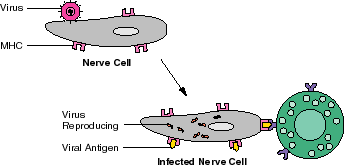 | ||||||||||||||||||||||||||||||||||||||||||||||||||||||||||||||||||||||||||||||||||||||||||||||||||||||||||||||||
| However, for the T cell to respond to a foreign antigen on the MHC,
another molecule on the antigen-presenting cell must send a second signal
to the T cell. A corresponding molecule on the surface of the T cells
recognizes the second signal. These two secondary molecules of the
antigen-presenting cell and the T cell are called co-stimulatory
molecules. There are several different sets of co-stimulatory molecules
that can participate in the interaction of antigen-presenting cell with a
T cell. Once the MHC and the T-cell receptor interact, and the co-stimulatory molecules interact, there are several possible paths that the T cell may take. These include T cell activation, tolerance, or T cell death. The subsequent steps depend in part on which co-stimulatory molecules interact and how well they interact. Because these interactions are so critical to the response of the immune system, researchers are intensively studying them to find new therapies that could control or stop the immune system attack on self tissues and organs. | |||||||||||||||||||||||||||||||||||||||||||||||||||||||||||||||||||||||||||||||||||||||||||||||||||||||||||||||||
| An antigen-presenting cell (for example, a macrophage) with a foreign antigen on its MHC is recognized by a T-cell receptor. In addition, co-stimulatory molecules on the antigen-presenting cell and the T cell interact. | 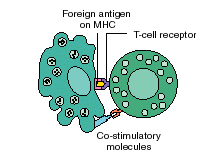 | ||||||||||||||||||||||||||||||||||||||||||||||||||||||||||||||||||||||||||||||||||||||||||||||||||||||||||||||||
| Cytokines and Chemokines
One way T cells can respond after the interaction of the MHC and the T-cell receptor, and the interaction of the co-stimulatory molecules, is to secrete cytokines and chemokines. Cytokines are proteins that may cause surrounding immune system cells to become activated, grow, or die. They also may influence non-immune system tissues. For example, some cytokines may contribute to the thickening of the skin that occurs in people with scleroderma. | |||||||||||||||||||||||||||||||||||||||||||||||||||||||||||||||||||||||||||||||||||||||||||||||||||||||||||||||||
| After the antigen-presenting cell and T cell interact through the MHC, T-cell receptor and co-stimumlatory and molecules, the T cell becomes activated, sending cytokine signals to other cells. | 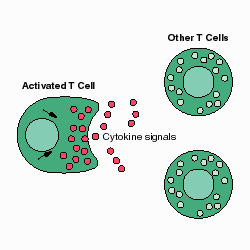 | ||||||||||||||||||||||||||||||||||||||||||||||||||||||||||||||||||||||||||||||||||||||||||||||||||||||||||||||||
| Chemokines are small cytokine molecules that attract cells of the immune system. Overproduction of chemokines contributes to the invasion and inflammation of the target organ, which occurs in autoimmune diseases. For example, overproduction of chemokines in the joints of people with rheumatoid arthritis may result in invasion of the joint space by destructive immune system cells such as macrophages, neutrophils, and T cells. | |||||||||||||||||||||||||||||||||||||||||||||||||||||||||||||||||||||||||||||||||||||||||||||||||||||||||||||||||
| Antibodies B cells are another critical type of immune system cell. They participate in the removal of foreign antigens from the body by using a surface molecule to bind the antigen or by making specific antibodies that can search out and destroy specific foreign antigens. However, the B cell can only make antibodies when it receives the appropriate command signal from a T cell. Once the T cell signals the B cell with a type of cytokine that acts as a messenger molecule, the B cell is able to produce a unique antibody that targets a particular antigen. | |||||||||||||||||||||||||||||||||||||||||||||||||||||||||||||||||||||||||||||||||||||||||||||||||||||||||||||||||
| A T cell sends messenger molecules, e.g. cytokines, to the B cell, which allows the B cell to start making antibodies. | 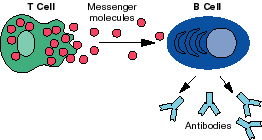 | ||||||||||||||||||||||||||||||||||||||||||||||||||||||||||||||||||||||||||||||||||||||||||||||||||||||||||||||||
| Autoantibodies In some autoimmune diseases, B cells mistakenly make antibodies against tissues of the body (self antigens) instead of foreign antigens. Occasionally, these autoantibodies either interfere with the normal function of the tissues or initiate destruction of the tissues. People with myasthenia gravis experience muscle weakness because autoantibodies attack a part of the nerve that stimulates muscle movement. In the skin disease pemphigus vulgaris, autoantibodies are misdirected against cells in the skin. The accumulation of antibodies in the skin activates other molecules and cells to break down, resulting in skin blisters. | |||||||||||||||||||||||||||||||||||||||||||||||||||||||||||||||||||||||||||||||||||||||||||||||||||||||||||||||||
| Immune Complexes and the Complement
System When many antibodies are bound to antigens in the bloodstream, they form a large lattice network called an immune complex. Immune complexes are harmful when they accumulate and initiate inflammation | |||||||||||||||||||||||||||||||||||||||||||||||||||||||||||||||||||||||||||||||||||||||||||||||||||||||||||||||||
| A large immune complex. |  | ||||||||||||||||||||||||||||||||||||||||||||||||||||||||||||||||||||||||||||||||||||||||||||||||||||||||||||||||
| within small blood vessels that nourish tissues. Immune complexes, immune cells, and inflammatory molecules can block blood flow and ultimately destroy organs such as the kidney. This can occur in people with systemic lupus erythematosus. | |||||||||||||||||||||||||||||||||||||||||||||||||||||||||||||||||||||||||||||||||||||||||||||||||||||||||||||||||
| If immune complexes accumulate in the kidney, they may promote movement of other inflammatory cells and molecules into the kidney. | 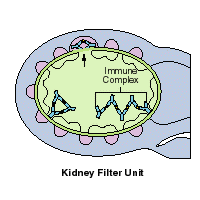 | ||||||||||||||||||||||||||||||||||||||||||||||||||||||||||||||||||||||||||||||||||||||||||||||||||||||||||||||||
| A group of specialized molecules that form the complement system helps to remove immune complexes. The different types of molecules of the complement system, which are found in the bloodstream and on the surfaces of cells, make immune complexes more soluble. Complement molecules prevent formation and reduce the size of immune complexes so they do not accumulate in the wrong places (organs and tissues of the body). Rarely, some people inherit defective genes for a complement molecule from their parents. Because these individuals cannot make a normal amount or type of complement molecule, their immune systems are unable to prevent immune complexes from being deposited in different tissues and organs. These people develop a disease that is not autoimmune but resembles lupus erythematosus. | |||||||||||||||||||||||||||||||||||||||||||||||||||||||||||||||||||||||||||||||||||||||||||||||||||||||||||||||||
| Genetic Factors Genetic factors can affect an individual's immune system and its responses to foreign antigens in several ways. Genes determine the variety of MHC molecules that individuals carry on their cells. Genes also influence the potential array of T-cell receptors present on T cells. In fact, some MHC genes are associated with autoimmune diseases. However, genes are not the only factors involved in determining a person's susceptibility to an autoimmune disease. For example, some individuals who carry disease-associated MHC molecules on their cells will not develop an autoimmune disease. | |||||||||||||||||||||||||||||||||||||||||||||||||||||||||||||||||||||||||||||||||||||||||||||||||||||||||||||||||
| How Are Autoimmune Diseases Diagnosed? | The diagnosis of an autoimmune disease is based on an individual's
symptoms, findings from a physical examination, and results from
laboratory tests. Autoimmune diseases can be difficult to diagnose,
particularly early in the course of the disease. Symptoms of many
autoimmune diseases—such as fatigue—are nonspecific. Laboratory test
results may help but are often inadequate to confirm a diagnosis.
If an individual has skeletal symptoms such as joint pain and a positive but nonspecific lab test, she or he may be diagnosed with the confusing name of early or "undifferentiated" connective tissue disease. In this case, a physician may want the patient to return frequently for follow up. The early phase of disease may be a very frustrating time for both the patient and physician. On the other hand, symptoms may be short-lived, and inconclusive laboratory tests may amount to nothing of a serious nature. | ||||||||||||||||||||||||||||||||||||||||||||||||||||||||||||||||||||||||||||||||||||||||||||||||||||||||||||||||
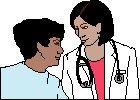 |
In some cases, a specific diagnosis can be made. A diagnosis shortly
after onset of a patient's symptoms will allow for early aggressive
medical therapy; and for some diseases, patients will respond completely
to treatments if the reason for their symptoms is discovered early in the
course of their disease. Although autoimmune diseases are chronic, the course they take is unpredictable. A doctor cannot foresee what will happen to the patient based on how the disease starts. Patients should be monitored closely by their doctors so environmental factors or triggers that may worsen the disease can be discussed and avoided and new medical therapy can be started as soon as possible. Frequent visits to a doctor are important in order for the physician to manage complex treatment regimens and watch for medication side effects. | ||||||||||||||||||||||||||||||||||||||||||||||||||||||||||||||||||||||||||||||||||||||||||||||||||||||||||||||||
| How Are Autoimmune Diseases Treated? | Autoimmune diseases are often chronic, requiring lifelong care and
monitoring, even when the person may look or feel well. Currently, few
autoimmune diseases can be cured or made to "disappear" with treatment.
However, many people with these diseases can live normal lives when they
receive appropriate medical care. Physicians most often help patients manage the consequences of inflammation caused by the autoimmune disease. For example, in people with Type 1 diabetes, physicians prescribe insulin to control blood sugar levels so that elevated blood sugar will not damage the kidneys, eyes, blood vessels, and nerves. However, the goal of scientific research is to prevent inflammation from causing destruction of the insulin-producing cells of the pancreas, which are necessary to control blood sugars. On the other hand, in some diseases such as lupus or rheumatoid arthritis, medication can occasionally slow or stop the immune system's destruction of the kidneys or joints. Medications or therapies that slow or suppress the immune system response in an attempt to stop the inflammation involved in the autoimmune attack are called immunosuppressive medications. These drugs include corticosteroids (prednisone), methotrexate, cyclophosphamide, azathioprine, and cyclosporin. Unfortunately, these medications also suppress the ability of the immune system to fight infection and have other potentially serious side effects. In some people, a limited number of immuno-suppressive medications may result in disease remission. Remission is the medical term used for "disappearance" of a disease for a significant amount of time. Even if their disease goes into remission, patients are rarely able to discontinue medications. The possibility that the disease may restart when medication is discontinued must be balanced with the long-term side effects from the immunosuppressive medication. A current goal in caring for patients with autoimmune diseases is to find treatments that produce remissions with fewer side effects. Much research is focused on developing therapies that target various steps in the immune response. New approaches such as therapeutic antibodies against specific T cell molecules may produce fewer long-term side effects than the chemotherapies that now are routinely used. Ultimately, medical science is striving to design therapies that prevent autoimmune diseases. To this end, a significant amount of time and resources are spent studying the immune system and pathways of inflammation. | ||||||||||||||||||||||||||||||||||||||||||||||||||||||||||||||||||||||||||||||||||||||||||||||||||||||||||||||||
| What Are Some Examples of Autoimmune Diseases? | Rheumatoid Arthritis In people with rheumatoid arthritis, the immune system predominantly targets the lining (synovium) that covers various joints. Inflammation of the synovium is usually symmetrical (occurring equally on both sides of the body) and causes pain, swelling, and stiffness of the joints. These features distinguish rheumatoid arthritis from osteoarthritis, which is a more common and degenerative "wear-and-tear" arthritis. | ||||||||||||||||||||||||||||||||||||||||||||||||||||||||||||||||||||||||||||||||||||||||||||||||||||||||||||||||
| An inflamed joint—the synovium—is attacked by cells and molecules of the immune system. | 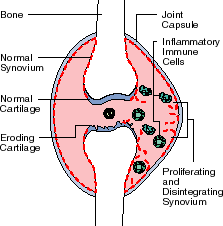 | ||||||||||||||||||||||||||||||||||||||||||||||||||||||||||||||||||||||||||||||||||||||||||||||||||||||||||||||||
| Currently available therapy focuses on reducing inflammation of the joints with anti-inflammatory or immunosuppresssive medications. Sometimes, the immune system may also target the lung, blood vessels, or eye; occasionally patients may also develop symptoms of other autoimmune diseases such as Sjogren's the inflammation, itching, and scaling. For more severe cases, oral medications are used. Psoriasis is common and may affect more than 2 out of 100 Americans. Psoriasis often runs in families. | |||||||||||||||||||||||||||||||||||||||||||||||||||||||||||||||||||||||||||||||||||||||||||||||||||||||||||||||||
| Multiple Sclerosis
Multiple sclerosis is a disease in which the immune system targets nerve tissues of the central nervous system. Most commonly, damage to the central nervous system occurs intermittently, allowing a person to lead a fairly normal life. At the other extreme, the symptoms may become constant, resulting in a progressive disease with possible blindness, paralysis, and premature death. Some medications such as beta interferon are helpful to people with the intermittent form of multiple sclerosis. In young adults, multiple sclerosis is the most common disabling disease of the nervous system. Multiple sclerosis afflicts 1 in 700 people in this country. Researchers continue to search for triggers of the disease. | |||||||||||||||||||||||||||||||||||||||||||||||||||||||||||||||||||||||||||||||||||||||||||||||||||||||||||||||||
 |
Immune-Mediated or Type 1 Diabetes
Mellitus Type 1 diabetes mellitus results from autoimmune destruction of the insulin-producing cells of the pancreas. Insulin is required by the body to keep the blood sugar (glucose) level under control. High levels of glucose are responsible for the symptoms and the complications of the disease. However, most of the insulin-producing cells are destroyed before the patient develops symptoms of diabetes. Symptoms include fatigue, frequent urination, increased thirst, and possible sudden confusion. Type 1 diabetes mellitus is usually diagnosed before the age of 30 and may be diagnosed as early as the first month of life. Together with Type 2 diabetes (not considered an autoimmune disease), diabetes mellitus is the leading cause of kidney damage, loss of eyesight, and leg amputation. Close control of sugar levels decreases the rate at which these events occur. There is a genetic predisposition to Type 1 diabetes, which occurs in 1 out of 800 people in the United States. Among individuals who have a close relative with Type 1 diabetes, those at high risk for developing disease can be identified. Efforts are now under way to evaluate prevention strategies for these family members at risk. | ||||||||||||||||||||||||||||||||||||||||||||||||||||||||||||||||||||||||||||||||||||||||||||||||||||||||||||||||
| Sunlight is one of the triggers of lupus and can worsen the progression of the disease. | Inflammatory Bowel Diseases
This medical term is used for both Crohn's disease and ulcerative colitis, two diseases in which the immune system attacks the gut (intestine). Patients may have diarrhea, nausea, vomiting, abdominal cramps, and pain that can be difficult to control. Illness in afflicted individuals can result from intestinal inflammation and from side effects of the drugs used for the disease. For example, daily use of high-dose corticosteroid (prednisone) therapy, which is needed to control severe symptoms of Crohn's disease, can predispose patients to infections, bone thinning (osteoporosis), and fractures. For patients with ulcerative colitis, surgical removal of the lower intestine (colon) will eliminate the disease and their increased risk for colon cancer. More than 1 in 500 Americans has some type of inflammatory bowel disease. | ||||||||||||||||||||||||||||||||||||||||||||||||||||||||||||||||||||||||||||||||||||||||||||||||||||||||||||||||
 |
Systemic Lupus Erythematosus
Patients with systemic lupus erythematosus most commonly experience profound fatigue, rashes, and joint pains. In severe cases, the immune system may attack and damage several organs such as the kidney, brain, or lung. For many individuals, symptoms and damage from the disease can be controlled with available anti-inflammatory medications. However, if a patient is not closely monitored, the side effects from the medications can be quite serious. Lupus occurs in 1 out of 2,000 Americans and in as many as 1 in 250 young, African-American women. | ||||||||||||||||||||||||||||||||||||||||||||||||||||||||||||||||||||||||||||||||||||||||||||||||||||||||||||||||
| Psoriasis Psoriasis is an immune system disorder that affects the skin, and occasionally the eyes, nails, and joints. Psoriasis may affect very small areas of skin or cover the entire body with a buildup of red scales called plaques. The plaques are of different sizes, shapes, and severity and may be painful as well as unattractive. Bacterial infections and pressure or trauma to the skin can aggravate psoriasis. Most treatments focus on topical skin care to relieve the inflammation, itching, and scaling. For more severe cases, oral medications are used. Psoriasis is common and may affect more than 2 out of 100 Americans. Psoriasis often runs in families. | |||||||||||||||||||||||||||||||||||||||||||||||||||||||||||||||||||||||||||||||||||||||||||||||||||||||||||||||||
| Scleroderma This autoimmune disease results in thickening of the skin and blood vessels. Almost every patient with scleroderma has Raynaud's, which is a spasm of the blood vessels of the fingers and toes. Symptoms of Raynaud's include increased sensitivity of the fingers and toes to the cold, changes in skin color, pain, and occasionally ulcers of the fingertips or toes. In people with scleroderma, thickening of skin and blood vessels can result in loss of movement and shortness of breath or, more rarely, in kidney, heart, or lung failure. The estimated number of people with any type of scleroderma varies from study to study but may range from 1 to 4 affected individuals for every 10,000 Americans (or as many as 1 out of 2500 individuals). | |||||||||||||||||||||||||||||||||||||||||||||||||||||||||||||||||||||||||||||||||||||||||||||||||||||||||||||||||
| Autoimmune Thyroid Diseases
Hashimoto's thyroiditis and Grave's disease result from immune system destruction or stimulation of thyroid tissue. Symptoms of low (hypo-) or overactive (hyper-) thyroid function are nonspecific and can develop slowly or suddenly; these include fatigue, nervousness, cold or heat intolerance, weakness, changes in hair texture or amount, and weight gain or loss. The diagnosis of thyroid disease is readily made with appropriate laboratory tests. | |||||||||||||||||||||||||||||||||||||||||||||||||||||||||||||||||||||||||||||||||||||||||||||||||||||||||||||||||
| The thyroid gland affect many parts of the body. | 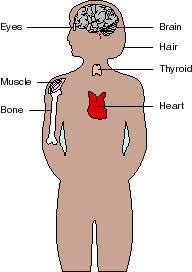 | ||||||||||||||||||||||||||||||||||||||||||||||||||||||||||||||||||||||||||||||||||||||||||||||||||||||||||||||||
| The symptoms of hypothyroidism are controlled with replacement thyroid hormone pills; however, complications from over- or under-replacement of the hormone can occur. Treatment of hyperthyroidism requires long-term anti-thyroid drug therapy or destruction of the thyroid gland with radioactive iodine or surgery. Both of these treatment approaches carry certain risks and long-term side effects. Autoimmune thyroid diseases afflict as many as 4 out of 100 women and are frequently found in families where there are other autoimmune diseases. | |||||||||||||||||||||||||||||||||||||||||||||||||||||||||||||||||||||||||||||||||||||||||||||||||||||||||||||||||
| What Research Is Under Way on Autoimmune Diseases? | The National Institute of Allergy and Infectious Diseases (NIAID)
supports research studies on the function of the immune system in various
diseases. A basic understanding of the human immune system is central to
the understanding of the development of an autoimmune disease (disease
pathogenesis). Scientists searching for ways to prevent and treat
autoimmune disease are studying disease pathogenesis and investigating new
ways to modify the immune system. Specifically, investigators supported by NIAID are focusing on: 1) studies of the immune system during the progression of an autoimmune disease; 2) analysis of the influence of genetics on autoimmune disease expression and progression; 3) the role of infectious agents in autoimmune diseases; 4) studies of animal models of autoimmune diseases; and 5) the effects of therapeutic intervention on the immune system in an autoimmune disease. In addition, studies of a specific autoimmune disease such as multiple sclerosis can provide new and additional insights into the pathogenesis of autoimmune diseases affecting other organ systems. Therefore, NIAID also supports studies on specific autoimmune diseases in cooperation with other Institutes of the National Institutes of Health that focus on organ-specific autoimmune diseases. | ||||||||||||||||||||||||||||||||||||||||||||||||||||||||||||||||||||||||||||||||||||||||||||||||||||||||||||||||
| Resources | National Institutes of Health (NIH) Resources
The following NIH components support medical research and/or provide information on varying aspects of autoimmune diseases. National Institute of Allergy and Infectious Diseases Office of Communications Bldg. 31/Rm. 7A50 31 Center Drive, MSC 2520 Bethesda, MD 20892-2520 (301) 496-5717 http://www.niaid.nih.gov/publications/ and http://www.niaid.nih.gov/recruit/recruit.htm (for clinical trials information) National Institute of Arthritis and Musculoskeletal and Skin Diseases Information Clearinghouse/NIH 1 AMS Circle Bethesda, MD 20892-3675 Fast Facts: (301) 881-2731 (to receive information by fax) Clearinghouse: (301) 495-4484 http://www.nih.gov/niams/healthinfo/ National Institute of Diabetes and Digestive and Kidney Diseases (NIDDK) Information Clearinghouse 1 Information Way Bethesda, MD 20892-3560 Diabetes, Digestive, and Kidney Diseases Information: (301) 654-3810 NIDDK Information Office (Thyroid Diseases) Bldg. 31/Rm. 9A04 31 Center Drive Bethesda, MD 20892-3560 (301) 496-3583 http://www.niddk.nih.gov/ National Institute of Neurological Disorders and Stroke Office of Scientific and Health Reports P.O. Box 5801 Bethesda, MD 20824 (301) 496-5751 http://www.ninds.nih.gov/hlthinhp.htm NIH Clinical Center Patient Recruitment and Referral Center—for specific NIH clinical trials information 4 West Drive, MSC 2655 Quarters 15 D-2 Bethesda, MD 20892-2655 (301) 411-1222 http://clinicalstudies.info.nih.gov/referring_patient.html Office of Rare Diseases, NIH Bldg. 31/Rm. 1B03 31 Center Drive Bethesda, MD 20892 (301) 402-4336 http://cancernet.nci.nih.gov/ord/p_home.htm | ||||||||||||||||||||||||||||||||||||||||||||||||||||||||||||||||||||||||||||||||||||||||||||||||||||||||||||||||
| Other Resources Sponsored by the Department of Health and
Human Services National Health Information Center (800) 336-4797 or (301) 565-4167 Health Finder: http://www.healthfinder.gov/ Combined Health Information Database http://chid.nih.gov/ | |||||||||||||||||||||||||||||||||||||||||||||||||||||||||||||||||||||||||||||||||||||||||||||||||||||||||||||||||
| Private Sector Organizations The following list is astarting point for additional information on autoimmune diseases. Many of the organizations have extensive educational resources, local chapters, and support groups. The Internet Web site of many organizations can refer you to other disease-oriented groups (for example, the Arthritis Foundation has alink to the Lupus Foundation). American Autoimmune Related Diseases Association 15475 Gratiot Avenue Detroit, MI 48205 (800) 598-4668 or (313) 371-8600 http://www.aarda.org/ American Diabetes Association 1660 Duke Street Alexandria, VA 22314 (800) 232-3472 or (703) 549-1500 http://www.diabetes.org/ American Liver Foundation 1425 Pompton Avenue Cedar Grove, NJ 07009 (800) 233-0179 and (973) 256-2550 http://sadieo.ucsf.edu/alf/alffinal/homepagealf.html American Thyroid Association Montefiore Medical Center 111 East 210th Street Bronx, NY 10467 Fax: (718) 882-6085 http://www.thyroid.org/ Arthritis Foundation 1650 Bluegrass Lakes Pkwy. Alpharetta, GA 30009 (800) 283-7800 or (800) 207-8633 http://www.arthritis.org/ Crohn's and Colitis Foundation of America National Headquarters 386 Park Avenue South, 17th Floor New York, NY 10016-8804 (800) 932-2423 (800) 343-3637 (Warehouse) http://www.ccfa.org/ Juvenile Diabetes Foundation International 120 Wall Street New York, NY 10005-4001 (800) JDF-CURE or (800) 533-2873 http://www.jdfcure.com/ Lupus Foundation of America 1300 Piccard Drive, Suite 200 Rockville, MD 20850-4303 (800) 558-0121 and (301) 670-9292 http://www.lupus.org/lupus Myasthenia Gravis Foundation of America 222 S. Riverside Plaza, Suite 1540 Chicago, IL 60606 (800) 541-5454 or (312) 258-0522 http://www.med.unc.edu/mgfa/ Myositis Association of America 1420 Huron Court Harrisonburg, VA 22801 (540) 433-7686 http://www.myositis.org/ National Alopecia Areata Foundation 710 CStreet, Suite 11 San Rafael, CA 94901-3853 or P.O. Box 150760 San Rafael, CA 94915-0760 (415) 456-4644 Fax: (415) 456-4274 http://weber.u.washington.edu/~dvictor/natl.html National Multiple Sclerosis Society 733 Third Avenue, 6th Floor New York, NY 10017-3288 (800) 344-4867 or (212) 986-3240 Fax: (212) 986-7981 http://www.nmss.org/ e-mail: [email protected] National Organization for Rare Disorders P.O. Box 8923 New Fairfield, CT 06812-1783 (800) 999-6673 http://www.nord-rdb.com/~orphan National Psoriasis Foundation 6600 SW 92nd Avenue, Suite 300 Portland, OR 97223 (800) 723-9166 or (503) 244-7404 http://www.psoriasis.org/ National Sjogren's Syndrome Association 5815 N. Black Canyon Highway, Suite 103 Phoenix, AZ 85015-2200 (602) 433-9844 http://www.sjogrens.org/ National Vitiligo Foundation P.O. Box 6337 Tyler, TX 75703 (903) 531-0074 Fax: (903) 531-9767 http://www.nvfi.org/ Sjogren's Syndrome Foundation 333 N. Broadway Jericho, NY 11753 1-800-4-SJOGRENS or (516) 933-6365 http://www.sjogrens.com/ Spondylitis Association of America P.O. Box 5872 Sherman Oaks, CA 91413 (800) 777-8189 or (888) 777-1594 http://www.spondylitis.org/ The S.L.E. Foundation 149 Madison Avenue, Suite 205 New York, NY 10016 (800) 745-8787 http://www.lupus.org/lupus United Scleroderma Foundation 89 Newbury Street, Suite 201 Danvers, MA 01923 800) 722-HOPE Fax: (978) 750-9902 http://www.scleroderma.org/ Wegener's Foundation 3705 South George Mason Drive, Suite 1813 Falls Church, VA 22041 (703) 931-5852 Wegener's Granulomatosis Support Group P.O. Box 28660 Kansas City, MO 64188-8668 (800) 277-9474 Fax: (816) 436-8211 http://www.wgsg.org/ | |||||||||||||||||||||||||||||||||||||||||||||||||||||||||||||||||||||||||||||||||||||||||||||||||||||||||||||||||
| Glossary | antibody: a molecule (also called an immunoglobulin) produced
by a B cell in response to an antigen. The binding of antibody to antigen
leads to the antigen's destruction. antigen: a substance or molecule that is recognized by the immune system. The molecule can be from a foreign material such as a bacterium or virus, or the molecule can be from the same organism (one's own body) and called a self antigen. antigen-presenting cell: a cell that displays an antigen with an MHC molecule on the cell surface. autoantibody: antibodies that are made against the body's own organs and tissues rather than foreignparts of bacteria or viruses. autoimmune disease: condition in which the immune system mistakenly attacks the body's own organs and tissues. | ||||||||||||||||||||||||||||||||||||||||||||||||||||||||||||||||||||||||||||||||||||||||||||||||||||||||||||||||
 |
B cell: a type of lymphocyte, which is an immune system cell.
Among its many roles, the B cell produces antibodies that bind antigens.
cells: the building blocks that make up tissues, organs, and bloodstream of the body. Immune system cells normally move throughout the bloodstream and reside temporarily in the lymph nodes, spleen, and thymus. chemokine: a substance manufactured by cells and tissues, that stimulates movement and activation of immune system cells to the area where the chemokine is produced. clinical trial: a prospective, scientific evaluation in human volunteers of a treatment regimen, device, or procedure used for the prevention, diagnosis, or treatment of a disease. complement system: this series of molecules works together to perform many immune system functions. For example, the complement system helps to dissolve and remove immune complexes and to kill foreign cells. co-stimulatory molecules: pairs of molecules on the surfaces of two cells that work together with the MHC and T-cell receptors of those cells. The co-stimulatory molecules help to stimulate or decrease the immune response produced by the two cells. cytokines: chemical substances that have varied effects on many cells of the body. For example, some cytokines can cause growth and activation of immune system cells. gene: a unit of genetic material that is inherited from a parent. A gene carries the directions that a cell uses to perform a specific function. | ||||||||||||||||||||||||||||||||||||||||||||||||||||||||||||||||||||||||||||||||||||||||||||||||||||||||||||||||
 |
immune complex: a cluster of interlocking antigens and
antibodies forming a large network of molecules.
inflammation: a collection of immune system cells and molecules that invade tissues and organs as part of an immune system response. lymphocyte: a type of white blood cell of the immune system. T cells and B cells are lymphocytes that look similar under the microscope but have different functions. macrophage: a type of white blood cell that functions as a patrol cell and engulfs and kills foreign infectious invaders. MHC (major histocompatibility complex) molecules: molecules that are found on cell surfaces and display antigen; the antigen-MHC molecules may then interact with a T-cell receptor. molecule: a small physical unit made up of chemical substances such as proteins, sugars or fats. Molecules are the building blocks of a cell. neutrophil: a type of immune system cell that combats infectious agents, in particular bacteria. Neutrophils contain granules filled with potent chemicals that can destroy bacteria or other nearby cells when the chemicals are released. reactive oxygen intermediate molecules: toxic molecules that are released by immune cells and help to destroy invading microbes. These molecules can sometimes destroy healthy body tissues nearby. | ||||||||||||||||||||||||||||||||||||||||||||||||||||||||||||||||||||||||||||||||||||||||||||||||||||||||||||||||
 |
T-cell: a type of lymphocyte. T cells have T-cell receptors
and, sometimes, co-stimulatory molecules on their cell surfaces. The T
cell helps to orchestrate the immune system and can issue "orders" for
other cells to make cytokines and chemokines. T-cell receptor: a molecule found on the surface of T cells. The T-cell receptor can recognize and interact with a corresponding MHC molecule that is displaying an antigen. tolerance: a state in which the T cell can no longer respond to antigen. | ||||||||||||||||||||||||||||||||||||||||||||||||||||||||||||||||||||||||||||||||||||||||||||||||||||||||||||||||